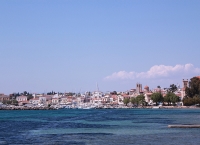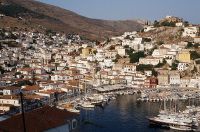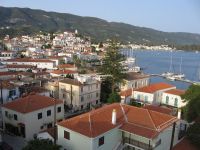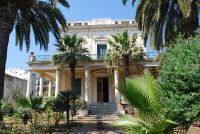Things to do in Saronic Gulf Islands
For Greeks and international tourists, the Saronic Gulf Islands are popular getaways from Athens, and each one has its own flavour. Aegina is the closest to Athens and, given its proximity to the capital, has become a holidaymaker's suburb of the city. Graced with lovely beaches, the busy, cosmopolitan island also has a rich and fascinating history. Visitors can enjoy attractions such as the Temple of Aphaia and the monastery at Agios Nektarios.
Hydra is considered the most beautiful of the Saronic Islands, with its quaint, picturesque main port accenting its gorgeous shores. Its booming tourist industry has not diminished its charm and character. Poros is known for its wooded, mountainous scenery and jolly nightlife. Apart from the exciting nighttime revelry in the waterfront area, its attractions include Bourtzi Castle, an Archaeological Museum, and the Sanctuary of Poseidon. Poros also has some great beaches.
Somewhat less crowded than islands such as Aegina, Spetses is extremely popular with luxury travellers, and has wonderful hiking and swimming locations. The endearingly picturesque port of Dapia has an old-fashioned charm. Agistri is very lovely, as well, and has a relaxed atmosphere. Its nightlife is nothing special within the Saronic Islands, but it's a wonderful destination for families.

Aegina
Aegina is the closest Saronic Gulf Island to Athens. As such, it's almost one of the city's suburbs, offering cosmopolitan shops, restaurants and accommodation. Formed largely from…
Aegina
Aegina is the closest Saronic Gulf Island to Athens. As such, it's almost one of the city's suburbs, offering cosmopolitan shops, restaurants and accommodation. Formed largely from an extinct volcano, the island was once the training place of Achilles' elite fighting unit, the Myrmidons. Today, it boasts a buffet of cultural attractions. The well-preserved Temple of Aphaia and the monastery at Agios Nektarios are time-honoured favourites. Visitors can also enjoy the pretty town of Perdika, though it's likely to be busy during peak season. By ferry, the rugged island is around 40 minutes away from Piraeus port, and is a wonderful setting for seaside holidays.

Hydra
Considered the most beautiful island in the Saronic Gulf, Hydra has a number of pretty towns with not a high-rise building or noisy car in sight thanks to zealous development restr…
Hydra
Considered the most beautiful island in the Saronic Gulf, Hydra has a number of pretty towns with not a high-rise building or noisy car in sight thanks to zealous development restrictions. The island isn't named for the mythical beast, the Hydra, but comes from the Greek word for water and pays tribute to the natural springs on the island.
Hydra port is the main village and the pretty, crescent-shaped harbour has some great restaurants, shops and galleries to entertain visitors. Steep and quaint stone streets lead upwards from the port, pebbled beaches ring Hydra's impressive mansions of wealthy Athenians, and there are worthwhile cultural attractions such as the Cathedral of Hydra and the Hydra Museum.
Other villages and hamlets on the island include Mandraki, Kamini, Vlychos, Palamidas, Episkopi and Molos but, as no cars are allowed, the only methods of transport are donkeys, bicycles and your own two feet. This adds to the charm of the place and it's wonderful to walk or ride around the island. Though the island is very beautiful, its longstanding reputation as a weekend getaway spot has obliterated most traditional ways of life in favour of catering to tourists.

Poros
The ancient name of Poros was Pogon and it's actually an island-pair inclusive of Sphairia, the southern, volcanic island where the modern city is located, and Kalaureia, the large
Poros
The ancient name of Poros was Pogon and it's actually an island-pair inclusive of Sphairia, the southern, volcanic island where the modern city is located, and Kalaureia, the larger, northern island. A bridge connects the two islands.
Poros, separated from the Peloponnase by only a few hundred metres, is a quiet, wooded island with scenic pine, olive and lemon groves and a pretty monastery, as well as two good beaches at Askeli and Neorio. It's lush and mountainous and a popular weekend getaway for locals and tourists. Graves on Poros have been dated to the Mycenaean period and evidence suggests that the island-pair have been inhabited since the Bronze Age. The Archaeological Museum is worth a visit and houses findings from the Sanctuary of Poseidon and other nearby ancient sites.
The city's main landmark is the clock tower, which was built in 1927; other attractions include Bourtzi Castle, built around 1828, and the original site of the Sanctuary of Poseidon, which dates to roughly 520 BC. The presence of a naval training base means that Poros Town's waterfront area is often lively and crowded at night. However, many visit Poros simply to relax and enjoy the lovely scenery and beaches.

Spetses
Spetses is a popular weekend destination in the Saronic Gulf, with towns full of white-washed mansions and fragrant pine forests. Catering more for wealthy travellers than package …
Spetses
Spetses is a popular weekend destination in the Saronic Gulf, with towns full of white-washed mansions and fragrant pine forests. Catering more for wealthy travellers than package tourists, the island's gently rolling hills are good for hiking, and intrepid explorers will find good swimming holes and beaches.
The island's little port of Dapia, the first impression visitors get of Spetses, is surrounded by whitewashed, Neoclassical houses and ringed by smart cafés and stylish boutiques. The highlight of the season in Spetses is the celebration of the Panaghia Armata, which re-enacts an 1822 naval battle between the Greek forces and the Turkish Armada. Although the island is now as peaceful as they come, cannons still line the promenade as testament to its proud militaristic past.
Part of Spetses's appeal is that the island remains comparatively undiscovered and travellers still get the feeling of being somewhere authentic, instead of touristy. Cars are banned from the central town area so locals still use horse-drawn carriages and bicycles to get around, which adds to the charm. Spetses is quite a pricey island, thanks to the upper-class Athenians who retreat here for holidays, but it's a very rewarding one.



